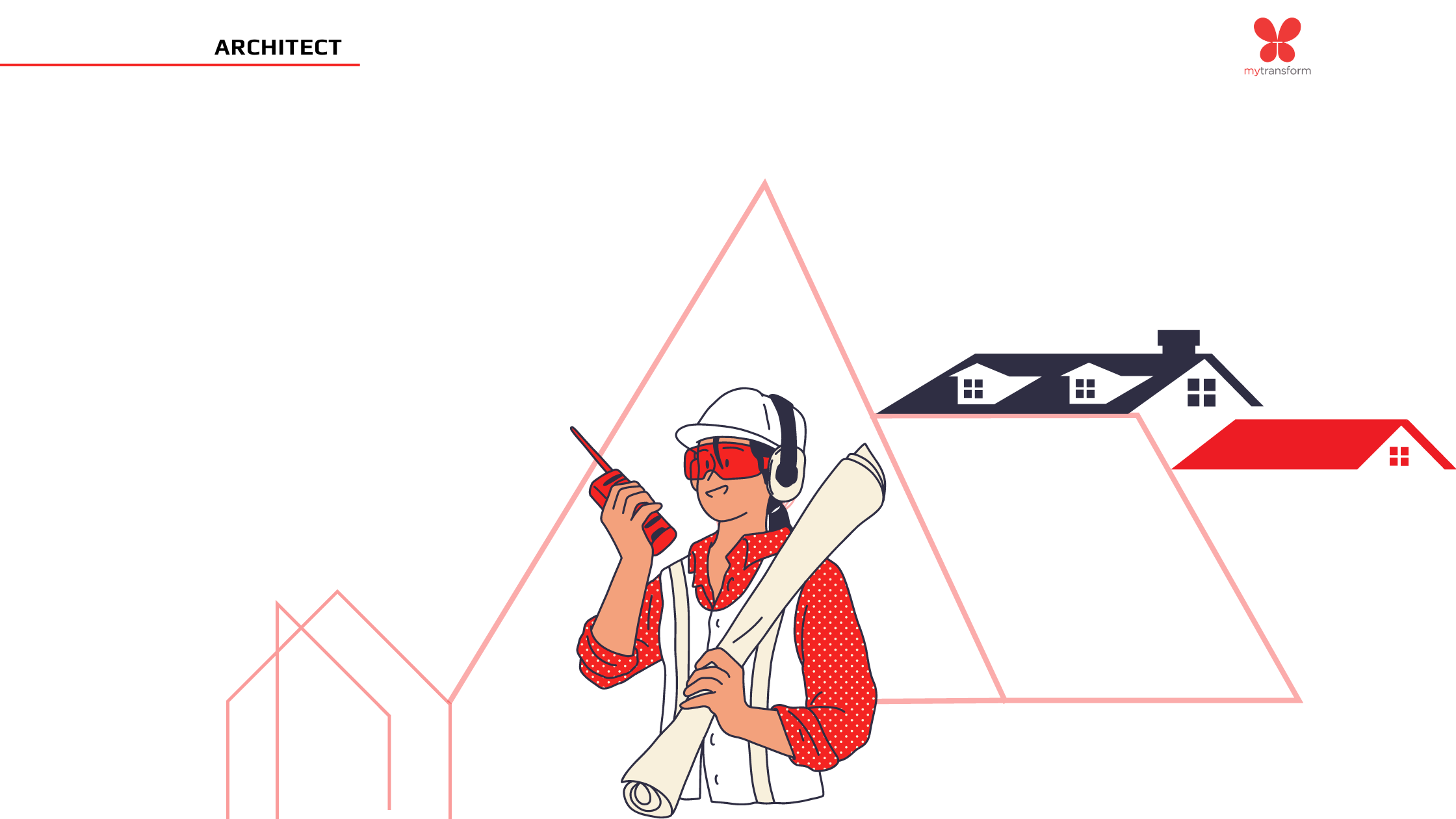
To become a licensed architect, students must first complete their professional degree in architecture.
When you first get your license, you’ll be in charge of tasks like applying for building permits, taking care of the day-to-day functions of projects, keeping track of project milestones, and talking to clients.
Once you’re a registered architect with reasonable experience, you’ll be in charge of things like leading a team, juggling multiple projects, understanding complicated laws, making project budgets, keeping an eye on construction, and many more such things.
Who is an Architect?
An architect is a licensed professional who drafts, draws, and plans to build structures.
If you become an architect, your ultimate responsibilities will depend on what kind of company you work for, how senior you are, and what type of work you do.
Professional architects say there’s something magical about visualizing a structure, sketching it out on paper or in a computer, and then turning that vision into a reality.
Architecture is one of those fields that includes a wide range of career options due to very few focuses that fall under its domain.
Types of Architects
The various types of architects are:
-
- Residential Architect
- Interior Architect
- Landscape Architect
- Industrial Architect
- Conservation Architect
- Sustainable / Green Design Architect
- Commercial Architect
- Urban Designer
1. Residential Architect
Residential architects design homes for private construction companies or estate development firms.
Although it is commonly regarded as a less prestigious option when compared to famous landmarks and skyscrapers, many renowned architects have also worked on residential properties.
It is especially important for a residential architect to be familiar with local building codes and neighborhood restrictions in order to adapt their designs.
Furthermore, because many designs are used in a variety of projects, it is critical that the designs be easily modified to accommodate a wide range of estate sizes and shapes.
Residential architects are also the best choice for home additions.
2. Interior Architect
An interior architect is in charge of making sure that the space is used to its full potential. They use modern construction and planning designs, as well as having a technical understanding of the space’s use case.
3. Landscape Architect
Landscape Architects are in high demand because many construction projects include green spaces such as parks and walkways.
These professionals are experts in the design of outdoor spaces such as public gardens, golf courses, and orchards. They must be well-versed in horticulture because they will be in charge of which plants are used and where.
It is crucial that they understand which plants will be suitable for the project’s climate, as well as how much space and maintenance each plant will require.
4. Industrial Architect
Industrial Architects are experts in designing functional and efficient buildings because they specialize in the design and construction of warehouses, factories, and data centers, among other things.
An industrial architect is capable of integrating the necessary equipment and machinery in such a way that the final building can be used in the most efficient manner.
5. Conservation Architect
Architecture encompasses not only the design of new structures but also the restoration and preservation of historic structures. It is critical that these structures be protected from the elements so that they can be enjoyed by future generations.
Conservation architects must understand how to maintain buildings while still honoring the period architecture of the historic building.
Furthermore, there are numerous restrictions placed on listed buildings that the architect must understand and work within.
6. Sustainable / Green Design Architect
A growing number of businesses are considering the environmental impact of their construction and the number of greenhouse gases produced during construction and operation.
This is where a sustainable design and construction method comes into play. It is critical for sustainable architecture to have a thorough understanding of how to reduce a building’s environmental impact.
This can range from the building’s construction methods and materials to its heating and lighting. As a result, a sustainable architect is likely to be far more involved in the building’s construction than other architects.
7. Commercial Architect
Most of the time, the most prestigious and well-known architects are the ones who design impressive highrise buildings that define a city.
These commercial architects do have the chance to work on projects that could make or break their careers. But these projects are often in the public eye and involve working directly with the client.
There is a lot more pressure because any mistakes can be just as bad for your career. Commercial architects have to think about both what the client wants and what the rules are for commercial properties, which are much stricter.
8. Urban Designer
In comparison to other types of architects, urban designers rarely work on a single building or project. They will instead work on city planning projects.
This can include enhancing the existing city and its infrastructure in preparation for the development of a new district.
An urban designer’s main focus will be on city zoning to ensure that housing, commercial, and industrial space are arranged in a sustainable and adequate infrastructure not only for current plans but also for future development.
What Do Architects Do? (Responsibility)
The roles and responsibilities of an architect are:
-
- Project Discussion
- Documentation and Drawings
- Cost Estimation
- Contracts
- Construction Stage
1. Project Discussion
A client hires an architect to create a detailed design of a concept or idea that the client wishes to realize.
Before the design is approved, meetings and discussions with various team members and engineering professionals take place.
Client requirements, expected budget, site characteristics, safety, and local planning regulations are some of the topics that must be discussed during those meetings.
2. Documentation and Drawings
Architects are in charge of making detailed drawings and making sure that a project is possible. This was done by hand in the past, but modern software like BIM and CAD makes the process much faster. During this stage, the design is changed and redrawn several times to fit the client’s needs, the budget, and the rules.
The final blueprints show builders how to build the structure that was planned. This includes plans for all of the building’s mechanical, electrical, and structural systems.
Along with the plans, there are other technical documents that need to be made, such as design instructions and technical specifications for contractors.
After the final design comes to the contract proposal, which lets you figure out how much the project will cost and how long it will take.
3. Cost Estimation
Estimating costs at different stages of a project lets you keep a better handle on the budget. Architects can see the whole structure of a building and come up with creative designs and ideas for the building industry. However, these designs also need a structural design and MEP installations.
Architects and engineers should be careful not to underestimate the cost of materials and the time it takes to build something. This helps them make accurate estimates of costs.
Architects can be in charge of estimating the cost of a whole building or just a part of it, like landscaping. In either case, the amount of detail they give depends on how much work they are doing.
4. Contracts
Architects can assist with contract negotiations and may recommend and select contractors for various activities. After receiving all tenders, the architect conducts analysis reports, and the results are compared to the client’s expectations and budget.
5. Construction Stage
When construction begins, the architect will conduct site visits and meetings, negotiate contracts, and deal with and resolve any problems that may arise. Some of the documentation that occurs during the construction phases will necessitate the architect’s signature and approval.
Eligibility to Become an Architect
Students seeking admission to the Bachelor of Architecture program must meet specific eligibility requirements.
The steps for meeting the eligibility criteria are as follows:
-
- Students applying for B. Arch must have completed 10+2 with mathematics as the main subject from a recognized board.
-
- Students must have received at least 50% in their most recent qualifying exam.
-
- Students who have completed a diploma in a relevant subject from a recognized university with at least 50% aggregate marks may also apply for B. Arch.
Skills Required to Become an Architect
Architects Must Have These Ten Skills:
-
- Design Skills
- Numerical Skills
- Creative Skills
- Communication Skills
- Legal Understanding
- Teamwork Skills
- Artistic Skills
- Problem-Solving Skills
- Visualization Skills
- Leadership and Management Skills
1. Design Skills
Designing is a crucial architecture skill that you must have.
To create models, drawings, and buildings, you should be skilled at design. You must have a solid understanding of design processes for this and thus meet your client’s needs.
2. Numerical Skills
A numerical skill is an important skill that you must have as an architect.
Architecture is all about mathematics; you must understand numerical principles, geometry, and advanced algebra.
3. Creative Skills
The next important skill that you must possess is creativity. You will need to develop different yet unique building ideas, just like in architecture.
You will benefit greatly from your creative abilities and make them a reality.
However, becoming creative is a slow process that requires you to be inspired by various ideas until you come up with something unique.
4. Communication Skills
Communication skills are essential in any field.
You will need to communicate with your clients, lawyers, construction manager, and others as an architect. And if you are bad at communicating, it will be difficult for you to convey your message, close deals with your clients, and so on.
5. Legal Understanding
Legal knowledge is also essential. Of course, you are free to come up with amazing construction ideas.
However, having a great idea is useless if it does not help in building codes, regulations, and policies.
Architecture should be aware of all building codes and policies and develop ideas solely around them.
6. Teamwork Skills
As an architect, you will have to work with others. It doesn’t matter if you want to work for someone else or start your own business.
If you are not a good team player, you will fall behind. You cannot handle or consider everything as a single person.
As a result, you will need to collaborate with others.
7. Artistic Skills
You should also be artistic. Architecting is all about design, and you will need to sit down and draw something at some point.
It makes no difference whether you use CAD software or pen and paper for the job.
And, because you have artistic skills, you will know which process and methods to use to design what you intend to design, as well as how to scale the design accurately.
8. Problem-Solving Skills
Problem-solving abilities are also required. You will encounter numerous problems throughout your career, whether they are design-related, legal-related, or otherwise.
It would be best if you were quick and efficient enough to deal with any problems that arise.
9. Visualization Skills
When your client gives you a brief of what they want, you should start imagining what the project should look like.
Visualization is an extremely important skill for art and design professionals to have.
As a result, when you sit down to begin drawing the project, you will have an idea of how it should look. Of course, you will need to make changes from time to time.
However, if you can visualize correctly, you will be able to create fantastic designs.
10. Leadership and Management Skills
One of the most important skills an architect must have is leadership and management.
Your job as an architect is to create a design, explain it to your clients, and persuade them that it is the best.
You will also have to collaborate with junior architects and technicians. And having basic leadership skills will be highly beneficial.
So you can ensure that the people around you are listening to you and that you are completing the project as you predicted.
How to Become an Architect? – Step-by-Step Guide
Here’s a step-by-step guide to help you:
1. After the 10th grade, opt for Science Stream.
If you want to be an architect, start right from high school.
After 10th grade, you must enter the science stream and choose mathematics as a major because construction planning requires numerous mathematical principles.
Architects must understand construction physics. Drawing helps with designing paper constructions.
2. Complete a Bachelor’s Degree
After high school, obtain a B. Arch.
The B.Arch is a 5-year program that teaches students the skills and knowledge needed to be an architect.
The course includes both theoretical and practical modules, resulting in highly qualified architects.
In addition to the standard BArch degree, you can also choose from specialized architecture bachelor’s degree programs such as:
-
- Bachelor’s in Engineering and Architectural Design
- Bachelor of Engineering in Landscape Architectur
- BSc/BA in Architecture Technology & Construction Management
- BA (Hons) in Interior Architecture & Design
The minimum requirement for a bachelor’s degree in architecture is 10+2, and if you plan to apply to Indian universities, you will also need to pass the NATA exam or another university-specific exam.
Students who wish to pursue these courses abroad must also have a valid score on required exams such as the ACT or SAT, as well as English proficiency exams such as TOEFL or IELTS.
3. Apply for a Job as an Architect
After passing the Architect Registration Examination and becoming licensed, you can apply to work as an architect.
You can work for a company, a private practice, or in the field where you interned.
4. Improve your skills by participating in training programs.
Before becoming a professional architect, all architects must complete a mandatory internship period (included in bachelor’s and master’s degree programs).
You will be required to work under a professional architect not only to gain exposure to all aspects of construction but also to gain experience as an architect.
5. Become a Registered/Licensed Architect
The final and most important step is to register as a professional architect or obtain a license.
Although you can work as an architect without a license in some countries after completing a bachelor’s degree in this field, getting a license opens up more job opportunities on a global scale.
In India, an architect must register with The Council Of Architecture (COA) and obtain a certificate from a recognized university before practicing.
6. Acquire Professional Certifications
In addition to the Architect Registration Examination, the National Council of Architectural Registration Boards provides extra-national certification.
While not required, this qualification may help you apply for architecture jobs in multiple states and demonstrate your professional abilities and expertise.
7. Complete a Master’s Degree
The next step in how to become an architect’s step-by-step guide is to pursue a master’s degree.
If you want to pursue a higher-level qualification after graduation, you can pursue a Master’s in Architecture (M.Arch) degree or a specialized master’s level Architecture program.
While many BArch graduates choose to seek employment after completing their bachelor’s degree, pursuing a postgraduate degree will allow you to gain expertise and specialize in a specific field.
Top Colleges/Institutes in India for Architects
Bachelor of Architecture Top Colleges in India:
| College Name | Average Fee (INR) |
| Indian Institute of Technology, Mumbai | 3,98,000 |
| Panjab University, Chandigarh | 4,08,000 |
| Indian Institute of Technology, Delhi | 1,48,709 |
| School of Planning & Architecture, New Delhi | 1,02,000 |
| Government College of Architecture & Sculpture, Malappuram | – |
| Government College of Architecture, Lucknow | 54,000 |
| Government Engineering College, Trichur | 22,150 |
| Ashoka Group of Institution | 75,000 |
| GITAM school of technology | 2,90,000 |
| BGS School of Architecture & Planning | 3,25,000 |
| Trinity College of Architecture | 1,27,000 |
| LJ School of Architecture | 3,20,000 |
| SAL School of Architecture | 97,000 |
| INDUS University | 1,17,000 |
| SAL School of Architecture | 97,000 |
| NIRMA University | 2,29,000 |
| CEPT University | 3,20,000 |
| APCOA | 1,14,000 |
| BVDU | 1,10,000 |
Architect Salary in India (Fresher, Mid-Level, Experienced)
Here is the salary chart of Architect in India along with the job profiles:
| Job profile | Salary (per annum) |
| Data Analyst | INR 3,96,128 |
| Architecture designer | INR 3,53,368 |
| Architecture engineer | INR 3,00,000 |
| Interior designer | INR 5,00,000 |
| Architecture draftsman | INR 3,44,450 |
| Staff consultant | INR 11,28,850 |
| Technical assistant | INR 2,85,502 |
| Project assistant | INR 3,02,715 |
| Architectural assistant | INR 2,08,700 |
| Building contractor | INR 5,50,000 |
| Landscape architect | INR 3,82,416 |
| Art director | INR 3,76,800 |
Benefits of an Architect as a Career
The Benefits of an Architect as a Career are:
-
- It’s an exciting and fast-paced career
- Interesting and creative work
- The field attracts people who are passionate and like-minded
- You have the ability to have an impact on the city and the people around you
- Respected career
- There is a lot of focus on travel
1. It’s an exciting and fast-paced career
The field of architecture is dynamic because technologies and techniques are constantly evolving.
Architects must continuously educate themselves in order to stay current in their field, which is both challenging and exciting.
An architect’s workday can be varied, with some days spent in the office, others spent visiting clients, and still, others spent on the job site.
2. Interesting and creative work
Architecture is a creative field that necessitates a high level of vision and expression. Seeing your vision and creativity come to life in your work can be extremely rewarding.
It’s incredibly satisfying to leave your creative imprint on a building, town, or even a city.
3. The field attracts people who are passionate and like-minded
Architects who have a unique perspective on the world with a strong appreciation for buildings, landscapes, and how architecture defines each city.
If you get excited when you see a new structure and your favorite thing to do in a new city is looking at the architecture, this could be the field for you.
4. You have the ability to have an impact on the city and the people around you
The influence of architecture is noticeable. You can see the structures and how they serve the city right in front of your eyes.
This impact is not only visible, but it can also last centuries and become part of a city’s historical identity.
5. Respected career
Becoming an architect is a complex but rewarding process. Architects are highly respected for their work and play an essential role in modern society.
6. There is a lot of focus on travel
Architects tend to travel a lot. It is very important for architects to understand how the architecture looks in different countries and cultures.
The more you’ve traveled and seen different styles of architecture and how they work in different cities, the better.
Disadvantages of an Architect as a Career
Disadvantages of an Architect as a Career:
-
- Less Paycheck
- You will be required to work long hours.
- Stationary Costs
- When you graduate, you are less likely to get a job.
- You will receive extensive training.
- The responsibility can be stressful.
1. Less Paycheck
The majority of architects still do not make as much as those in other professions, despite the fact that becoming an architect often requires years of study and training.
2. You will be required to work long hours.
This is not a job that ends every day at 5 o’clock. Even while you’re still in college, you’ll have to get used to working long hours. Getting what you want out of a project usually takes more than one try.
3. Stationary Costs
An architect may use four types of tools on a daily basis to complete a project: drawing tools, measuring tools, cutting tools, and computer software.
Meeting such costs day in and day out is mostly overwhelming on architects’ pockets.
4. When you graduate, you are less likely to get a job.
It can be difficult to find work after college, just like it can be challenging to find work anywhere else. Companies that are struggling cannot afford to hire architects to design buildings for them.
It all depends on the financial stability of the community in which you wish to reside.
5. You will receive extensive training.
Between four years in an undergraduate program and a few more in an internship, it will take about eight years before you can start working as an architect full-time. A lot of time and money are needed to become an architect.
6. The responsibility can be stressful.
Architects can face a lot of pressure to create beautiful structures that do everything they are supposed to do. This can sometimes make the job more stressful. However, all worthwhile things come with their own level of urgency.
Future Scope of Architect
In India, the scope of architecture is expanding. However, one cannot expect a good package if he leaves after completion.
The current trend is that after finishing architecture, a student can get a job in an architecture firm for a salary ranging from ₹15k to ₹20k per month.
After gaining enough experience and confidence, you will need to start your own firm.
Summary
-
- An architect is a licensed professional who drafts, draws, and plans to build structures.
-
- The various types of Architect are:
-
- Residential Architects
-
- Interior Architects
-
- Landscape Architects
-
- Industrial Architect
-
- Conservation Architect
-
- Sustainable / Green Design Architect
-
- Commercial Architect,
-
- Urban Designer
-
- The roles and responsibilities of an architect are:
-
- Project Discussion
-
- Documentation and Drawings
-
- Cost Estimation
-
- Contracts
-
- Construction Stage
-
- Students applying for B. Arch must have completed 10+2 with mathematics as the main subject from a recognized board.
-
- Architects Must Have These Ten Skills:
-
- Design Skills
-
- Numerical Skills
-
- Creative Skills
-
- Communication Skills
-
- Legal Understanding
-
- Teamwork Skills
-
- Artistic Skills
-
- Problem-Solving Skills
-
- Visualization Skills
-
- Leadership and Management Skills
-
- The Benefits of an Architect as a Career are:
-
- It’s an exciting and fast-paced career
-
- Interesting and creative work
-
- The field attracts people who are passionate and like-minded
-
- You have the ability to have an impact on the city and the people around you
-
- Respected career
-
- There is a lot of focus on travel
-
- The disadvantages of an Architect as a Career are:
-
- Less Paycheck
-
- You will be required to work long hours.
-
- Stationary Costs
-
- When you graduate, you are less likely to get a job.
-
- You will receive extensive training.
-
- The responsibility can be stressful.
-
- In India, the scope of architecture is expanding.
Frequently Asked Questions
After finishing 12th, you should pursue a Bachelor of Architecture (B. Arch) degree. It can be:
- Bachelor’s in Engineering and Architectural Design.
- Bachelor of Engineering in Landscape Architecture.
- BSc/BA in Architecture Technology & Construction Management
- BA (Hons) in Interior Architecture & Design.
It is recommended to do a 10+2 Science (Mathematics) stream and then appears for an entrance exam NATA. Then, you can take up a Bachelor of Architecture (B. Arch).
You could also get a Diploma after class 10th and then eventually move on to architecture engineering.
The first and most obvious step is to become a member of the Council of Architecture (COA) and obtain a certificate from a recognized university.
Documents must be attested by a Gazetted Officer or Notary Public/Oath Commissioner, or they must be self-attested.
Art, Art History, or Design and Technology would also be beneficial, and Physics is excellent preparation for the engineering aspects of studying Architecture.
In India, the average monthly salary for an architect is ₹23,636.
In India, the scope of architecture is expanding. Initially, the profession was highly underrated.
Students applying for B. Arch must have completed 10+2 with mathematics as the main subject from a recognized board.
Students must have received at least 50% in their most recent qualifying exam.
Students who have completed a diploma in a relevant subject from a recognized university with at least 50% aggregate marks may also apply for B. Arch.
With the necessary amounts of education and hands-on work experience, an ideal being will take 8 to 11 years of his/her life to be a successful architect.
Architecture is a difficult profession that requires a lot of effort. Architects who are successful have all made enormous sacrifices and worked extremely hard to get there.
In India, the average monthly salary for a Junior Architect is ₹17,458.
A mid-career Architect with 4-9 years of experience earns an average salary of ₹9.3 Lakhs per year.
An experienced Architect with 10-20 years of experience earns an average salary of ₹27.1 Lakhs per year.
Architects work 40-hour weeks and frequently work overtime and on weekends to meet deadlines.
Architecture is a viable career option in India, but there are numerous factors to be considered before pursuing it.
First and foremost, much groundwork must be completed. Only after many years of professional work can one become proficient.




